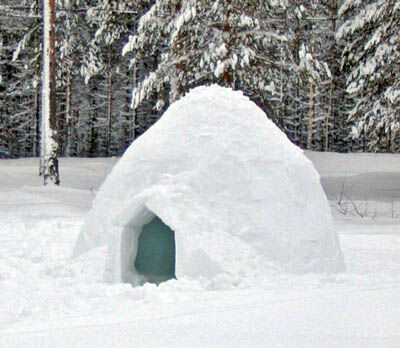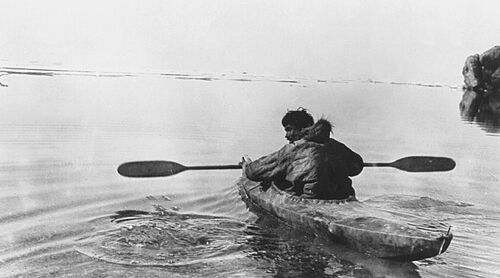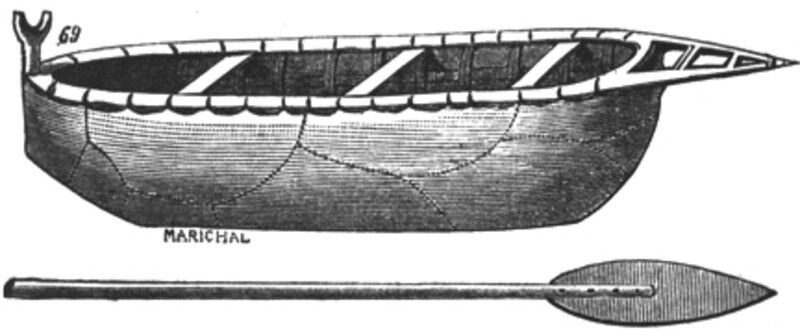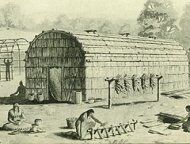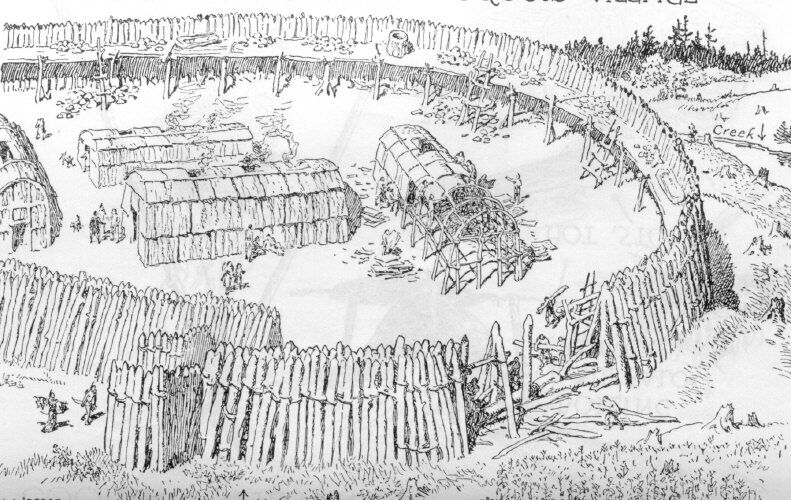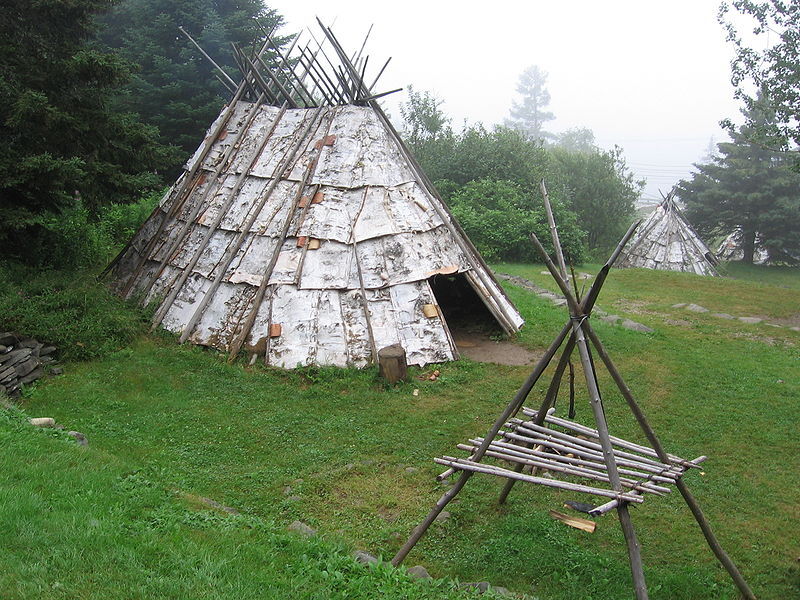The concepts covered in this factsheet go beyond those seen in secondary school. It is intended as a supplement for those who are curious to learn more.
Long before the arrival of Europeans, North America was inhabited by a multitude of peoples. From the Arctic to Central America, several indigenous nations lived and developed, some even forming empires.
The peoples of North America included the Inuit, Huron, Algonquin, Iroquois and Sioux.
|
Territory |
Lifestyle |
Social structure |
Housing |
Subsistence activity(ies) |
|
|
Inuit |
Canada's Far North | Nomadic according to season and resources | Clans | Summer: wooden houses Winter: mud huts and igloos |
Hunting Fishing |
| Huron | North of Lake Ontario | Sedentary | Clans, villages | Longhouses | Agriculture Hunting |
Algonquin |
Canada's mixed and boreal forests | Nomadic | Tribes | Wigwams | Hunting Foraging Fishing |
|
|
South of Lake Ontario and banks of the St. Lawrence River | Sedentary | Clans, villages | Longhouses | Agriculture Fishing |
| Sioux | Plains of the United States | Nomadic with horses | Tribes | Buffalo hide tepees | Buffalo hunting |
These inhabitants of the far north have adapted to the extreme cold and live mainly from hunting and fishing.
The Inuit are the long-standing people of the Arctic regions of North America. Their territory covers 6,000 kilometres stretching from the Bering Strait to eastern Greenland. In 2006, there were around 50,000 Inuit living in Canada. Inuit is an Inuktitut word meaning people. The Inuit have long been called Eskimos by other communities. This expression, which comes from the Cree language, means raw meat eaters and is not appreciated by the Inuit. These Arctic people are divided into eight major tribes.
Traces of the first Inuit have been found in north-west Alaska. These early Inuit lived mainly from hunting: seal, walrus, whale, caribou and so on. They built their homes from driftwood and earth. The size and quality of the meat from hunted animals meant that the Inuit of the time were able to live easily.
Around 1000, several small groups of Inuit began migrating towards the east of the continent. These people left in search of an easier life. Some groups settled in areas rich in whales. Large, prosperous villages sprang up around these areas. Smaller villages also sprang up in areas rich in seals, caribou and fish. House-building and hunting techniques were the same as in Alaska.
Around 1250, some Inuit probably encountered Viking settlers in south-west Greenland. However, these colonies disappeared in the middle of the 15th century: the Vikings were unable to withstand the cold, whereas the Inuit were adapted to it.
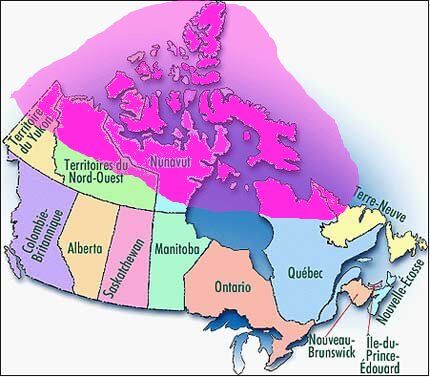
In pink, the territory traditionally occupied by the Inuit.
Note : English image coming soon!
In the 15th century, the climate became harsher as the Arctic experienced a minor ice age. Many Inuit headed south. Although they found a milder climate there, life proved more difficult: in these new regions, there were no whales to ensure their survival. It was at this time that some Inuit began to build houses out of snow blocks (igloos), which were easier and quicker to construct. In the 16th century, as European expansion began, the Inuit were the only Arctic inhabitants of North America.
Traditionally, the Inuit hunt for food. The animals hunted are not only used for food. The Inuit use oil and fat for cooking, and skins and fur to make clothes, blankets, tents and boats. They also use bones, ivory and wood to make tools. The animals they hunted were mainly caribou, seal, whale, bear, musk ox, fox and wolf. To supplement their diet, they also eat hares, ptarmigan, fish, berries and plants. For their clothing, the Inuit are able to create both waterproof and very warm garments, which is necessary for survival in such a harsh climate.
The Inuit generally use two types of house: a summer house and a winter house. Summer houses are tents made of skin and wood, while winter houses are mud huts with roofs made of wood and bone. Platforms are used to create raised beds, away from the cold ground. The Inuit also use a temporary shelter for hunting seasons: an igloo built from blocks of snow stacked to form a dome. Igloos are warm and easy to build.
The Inuit use several means of transport to get around. The kayak, invented by the Inuit, is widely used for hunting. This craft is specially designed to provide great stability on the water while keeping you warm.
To hunt the largest animals, the Inuit used an umiaq, a large rowboat. To get around on the land and on the ice floes, the Inuit travelled by dog sled, which enabled them to cover great distances with ease.
The language spoken by the Inuit community is Inuktitut, which is in fact a language made up of several dialects. Inuktitut is also represented by a syllabic script developed by missionaries. The symbols represent the meaning of the words.
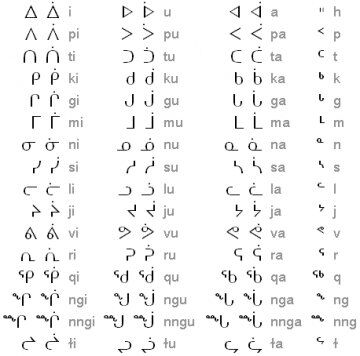
Symbols of Inuktitut
Traditional Inuit religion considers that everything that exists has a spirit. The most important spirit is that of the sea, known as Sedna. There is also a shaman who takes care of the sick. Music and dance play an important role in Inuit culture, and drum dancing and throat singing are still practised today. A number of Inuit art objects are still being created, including sculptures in wood, saponite, ivory, skin and bone. These objects are now sold all over the world.
One of the most representative objects of Inuit culture is undoubtedly the inukshuk. Made of large rocks piled one on top of the other, the inukshuk generally takes the shape of a person. These huge constructions were used to guide the Inuit during hunting season. They serve as landmarks to show the way home or where the herds are moving.
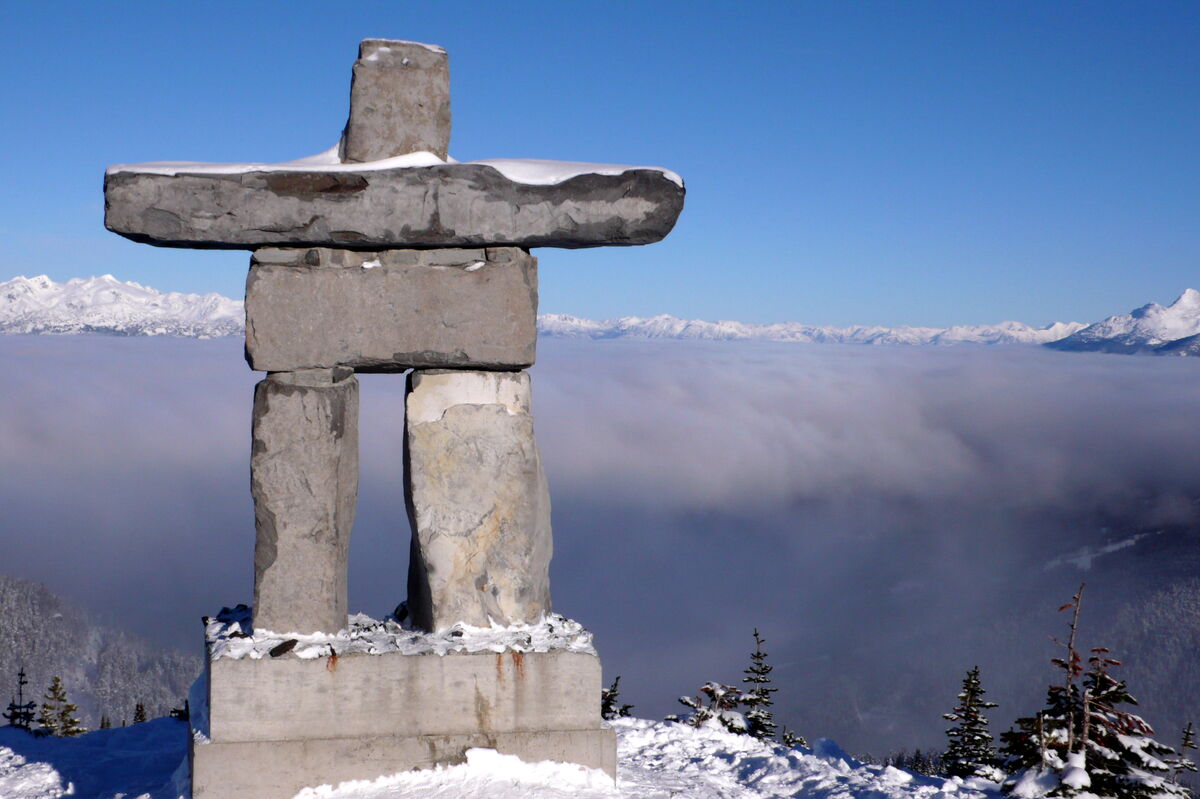
An inukshuk
Encounters with European explorers came a little later than for other indigenous peoples. However, the Inuit did come across several groups of explorers. Between 1570 and 1850, dozens of expeditions were organised in the North in search of a passage to the Pacific. For the Europeans, the Arctic was not a territory to be explored, but rather an obstacle standing between them and the riches of Asia. The first encounters between the two peoples were mainly for the purpose of barter.
This situation changed radically around 1850 when the first whaling expeditions began. Thousands of whales were slaughtered. This new industry employed many Inuit as hunters and seamstresses. This new economic activity brought a number of new objects to Inuit culture: guns, tents, flour, etc.
The whalers also brought with them contagious diseases to which the Inuit had no immunity. A number of Inuit lost their lives to these diseases, reducing the number of Inuit from 2,300 to around 150 in just a few decades. In the decades that followed, the Inuit took part in new commercial activities such as the fur trade with the Hudson's Bay Company. This Arctic people gradually lost their religion, their customs and, above all, their independent way of life.
After the Second World War, the Canadian government settled the Inuit in villages created expressly for them. This forced the Inuit to live a sedentary life, which increased their dependence on outside society. This new situation created a strong sense of exile among the Inuit and caused many difficulties in adapting. Since 1999, the Inuit have had their own territory: Nunavut (which means ‘ our land’). The Arctic remains an economically underdeveloped region, with few jobs, little education and few activities to stimulate the economy, which is based mainly on the exploitation of natural resources.
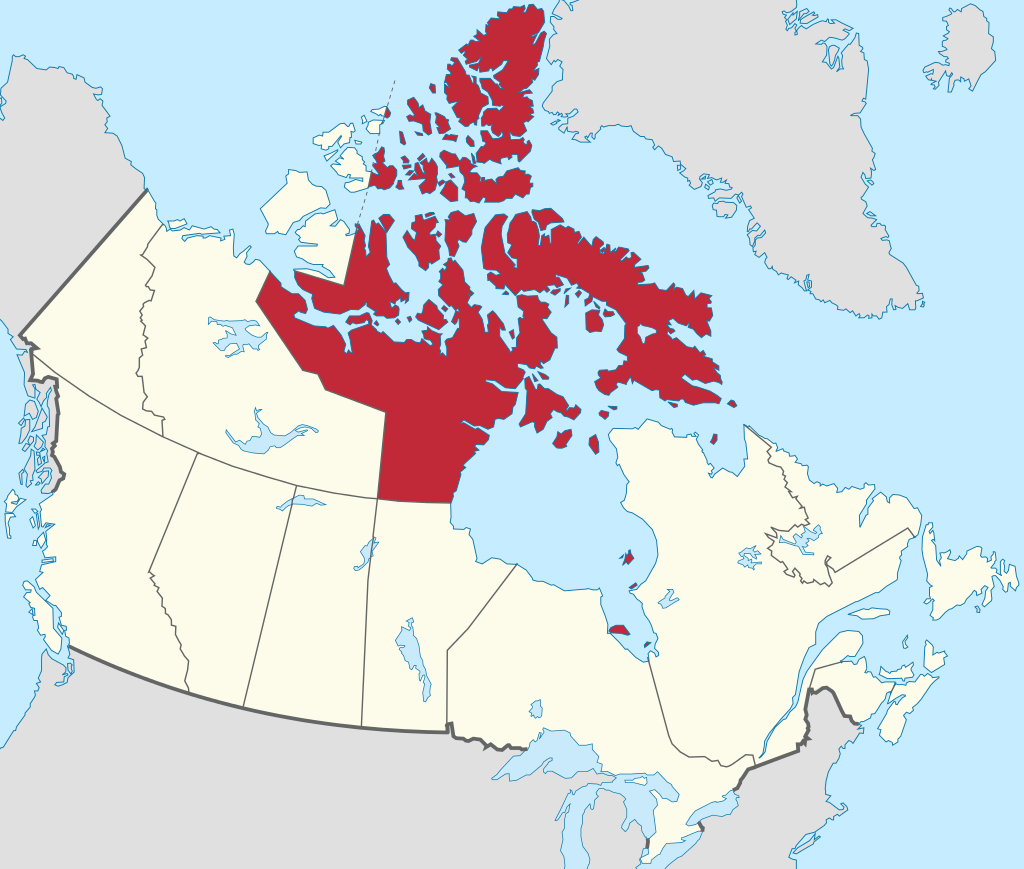
The territory of Nunavut
Although economic development is more difficult in Nunavut, the Inuit have regained control of their traditions, culture and education. Children in Nunavut are taught in the Inuktitut language.
These sedentary people, who live more from farming than from hunting and fishing, live mainly in northern Ontario. They are also known as Wendats.
The Huron are a group of five Iroquoian-speaking tribes. These tribes originally occupied northern Ontario. The name of the community is not Huron, but Wendat, meaning islanders.
The term Iroquoian refers to an Aboriginal language group in Canada. It includes the Iroquois, Mohawk and Huron.
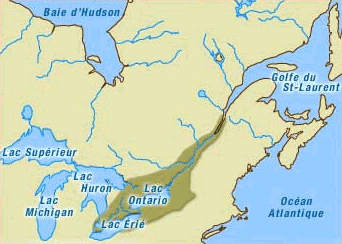
In dark, the Huron-Wendat territory
Note : English image coming soon!
The origins of the Wendat are fairly difficult to determine, as several legends exist that contradict each other. The five Wendat tribes formed an alliance against five other Iroquois tribes living in upstate New York. All these tribes went to war over a ceremony gone wrong. In the early 17th century, the Wendat population numbered between 20,000 and 25,000. The Huron are divided into 8 clans, each represented by a different animal.
The Wendat were mainly farmers. They grew corn, beans, squash and tobacco. They showed their farming techniques to other peoples. Their lives were based on the seasons and their lunar calendar. The biggest ceremonies took place in October at harvest time. They even managed to store surplus vegetables in cellars. Early autumn saw the start of the hunting season, with roe deer becoming the main source of food for the winter. In spring, the land was once again prepared for the next harvest, and the opportunity to produce new quantities of maple syrup was also taken.
The Huron diet was based almost exclusively on agricultural and hunting products. They supplemented their meals with nuts and berries. The Wendat lived in longhouses made of cedar planks and arch-shaped wooden frames. The houses were on average 7 metres long, and some could be as long as 30 metres. The houses could accommodate up to ten families. The houses were arranged so that each family had easy access to a fire for heating and cooking. Beds were on suspended platforms covered with bearskins.
The houses, which sometimes contained a storage room for preserving food, were surrounded by a palisade of wooden posts to protect the village.
The social structure is centred on the role of the mother. The family line was not passed down through the father, but through the mother. No marriage could take place within the same clan. To dress, the men wore a deer or beaver loincloth with moccasins. In winter, they added shirts, warm skins and fur capes to fight the cold. Women also wore moccasins with long skirts. Huron clothing was amply decorated with beads, shells, jewels, feathers and so on. The Wendat also often painted their bodies red.
All the Huron tribes speak an Iroquoian language similar to the other native languages. These tribes often organise festivals and rituals involving dancing, fighting, games and rites. The shamans, who may be men or women, are highly respected members of the clan. Not only can they heal the sick, but they can also interpret dreams and know about herbs. Dream interpretation is a very important activity for the Huron: miming dreams is thought to contribute to good health.
The first contact between the Hurons and Europeans took place during Jacques Cartier's expeditions. However, this initial contact was very limited. Closer ties were forged by Samuel de Champlain, who saw an opportunity to do business with the Wendat. Champlain offered to help the Hurons in their war against the Iroquois in exchange for goods such as furs. The French also offered them tools and firearms. However, the condition for these exchanges was that the Hurons converted.
Wars between native tribes became much more violent with the arrival of European weapons. The number of victims in each clan increased considerably. In addition, the contagious diseases brought by the colonists caused many deaths: 20,000 Aboriginals died of smallpox. The surviving tribes went to internal war. Some members wanted to mass convert to facilitate trade with the new arrivals, while others simply wanted to stay as they were.
As a result of these internal wars, some Wendats remained on Iroquois territory, while others decided to change territory, becoming Wyandots. After several small migrations, they settled in a village north of Quebec City: the village of Wendake.
Today, the language and culture have virtually disappeared due to the many marriages that took place between the Hurons and the French. Yet today's Hurons are very involved in Quebec aboriginal politics and have played a very active role in the recognition of aboriginal rights. They are fluent in French and many of them are bilingual.
The Algonquins are part of a larger indigenous group known as the Algonquians. They are a nomadic people who occupy the Canadian Shield and part of the Canadian Prairies.
The Algonquins, which means ‘real men’, are the largest and most dispersed of the Aboriginal groups. However, they are not a uniform group, but rather a collection of several hundred tribes. Their territory covers a very large part of Canada. This territory stretches from east of the Rocky Mountains through Hudson Bay to the Atlantic Ocean. The Algonquins are part of the Algonquians, the largest group of tribes. The Algonquin are related to the Abenaki.
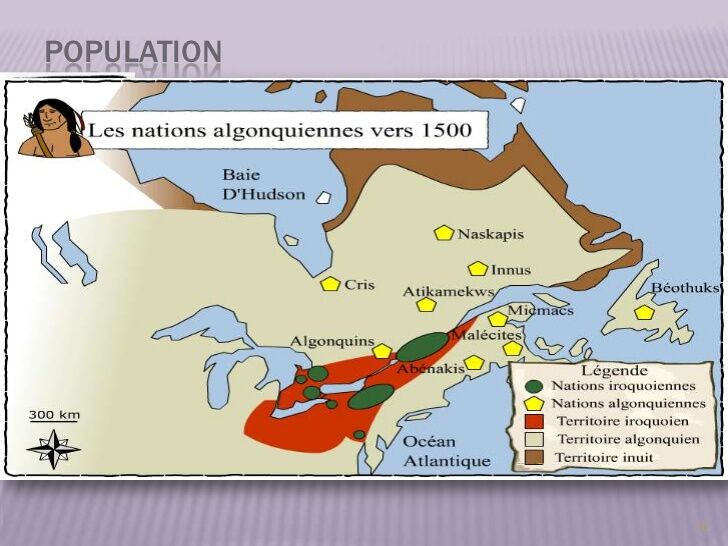
Map of Algonquian and Algonquin territories
Note : Emglish image coming soon!
The Algonquin tribe was mainly present in the Outaouais region. They were often at war with the Iroquois tribes.
The Algonquin way of life is nomadic. Life was organised around the cycle of the seasons, and the tribes moved according to the availability of resources. From early spring to late autumn, the Algonquins set up small villages close to waterways. During the summer months, they fish, hunt game and migratory birds, and gather berries. Their diet is rich and varied.
In late autumn, the Algonquins migrate to their hunting grounds. They divide into small bands of 10 to 20 people. Throughout the winter, they hunt big game (moose, caribou, elk, bear) to ensure their survival. They supplement their diet with small game such as hare, beaver, partridge and porcupine. Although famines are rare, the nomadic season is the most difficult of the year. However, the Algonquins put their trust in nature.
To hunt animals, they use their weapons: bows and arrows, spears, knives, traps and harpoons. They cooked their food in pots made of wood and bark. In fine weather, the Algonquins lived in wigwams, cone-shaped tents made of birch bark. In winter, they take shelter in similar tents that are smaller and easier to move around.
The women dress in long dresses and the men wear a loincloth and leggings. They all wore moccasins on their feet and capes when the climate was harsher. The Algonquins also used light-coloured paint to create warlike or decorative motifs. They travelled by birchbark canoe, dogsled, sled and snowshoe.
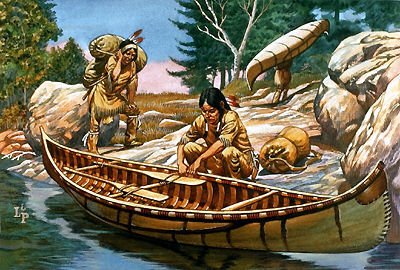
A birchbark canoe
In the tribes, women are responsible for foraging and looking after the family. It is women who pass on culture and traditions. They educate the children, make the clothes and prepare the meals. For their part, the Algonquin men had to hunt, fish and defend their tribe. In addition, it was the men who built the shelters and carried the canoes.
From the start of colonization, the Algonquins took refuge in the French forts. As they did not practise much agriculture, the Algonquins found many advantages in bartering with the colonists and Hurons. They obtained fishing nets, tools and utensils.
Colonization brought an era of greater prosperity for the Algonquins: hunting was easier and they took part in the fur trade. Little by little, the Algonquins changed their way of life and became increasingly dependent on the fur trade. In the early 19th century, with the decline in the fur trade and the increase in deforestation, the Algonquins adopted a totally sedentary lifestyle. They even put an end to hostilities with the Iroquois in order to join forces to improve the living conditions of the Aboriginal people.
This sedentary people made their living from agriculture. They were known as a warlike people, often at war with the Hurons. They occupied territories that were suitable for agriculture, such as the shores of Lake Ontario and the St. Lawrence Lowlands.
The Iroquois are a sedentary people who call their tribe the Big House People. Their territory is concentrated mainly on the shores of Lake Ontario and the banks of the St. Lawrence River.
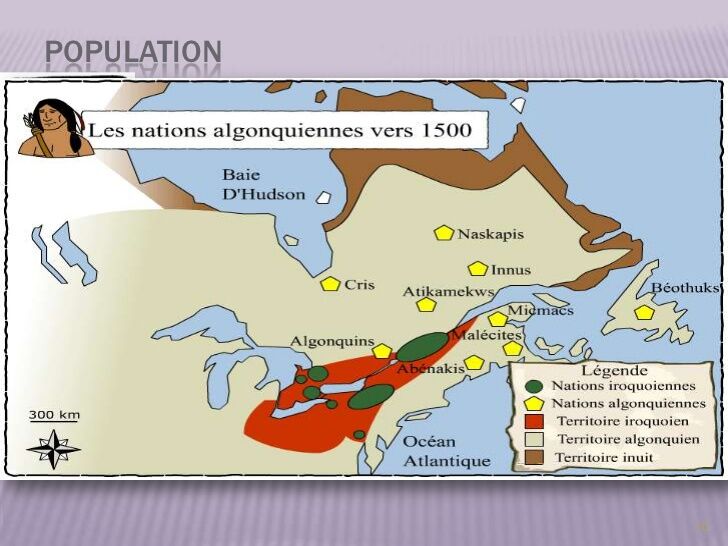
Iroquoian territory
Note : English image coming soon!
The first Iroquois settlements date back to 500 BC and were established in New York State. They introduced agriculture into their way of life around the year 1000. By the 15th century, the Iroquois consisted of five original tribes. These tribes were soon at war with the Hurons.
All the native communities were aware of the Iroquois' military reputation. As a result, the Iroquois' enemies quickly allied themselves with the French. The Iroquois often attacked French forts. Many Iroquois died of disease or during the wars.
As the Iroquois practised agriculture, they occupied the same territory for around twenty years. Iroquois tribes could consist of a considerable number of individuals. Their main economic activities were farming and fishing, so they could easily feed themselves no matter how large their group.
The Iroquois grew pumpkins, squash, beans, sunflowers, corn and tobacco. These foods formed the basis of their diet. To supplement this diet, they harvested fruit (apples and peaches) from their orchards. In addition, throughout the year, the tribe took part in other activities to vary the menu: hunting, fishing, foraging for berries, etc.
Because their farming techniques were so efficient, the Iroquois tribes were able to produce good harvests and accumulate surpluses. The Iroquois had developed methods of preserving food for use during poor harvests and in trade with other tribes. However, agricultural methods quickly exhausted the land. As they did not use fertiliser, they had to move their village every 10 or 30 years.
These moves were not easy, as they involved, among other things, the clearance of a new clearing and the construction of new houses and palisades. The villages were in fact large agglomerations that could contain more than 2,000 inhabitants. The houses are elongated multi-family dwellings. All the houses are arranged in a circle inside a wooden palisade. Behind the houses are the fields and the forest.
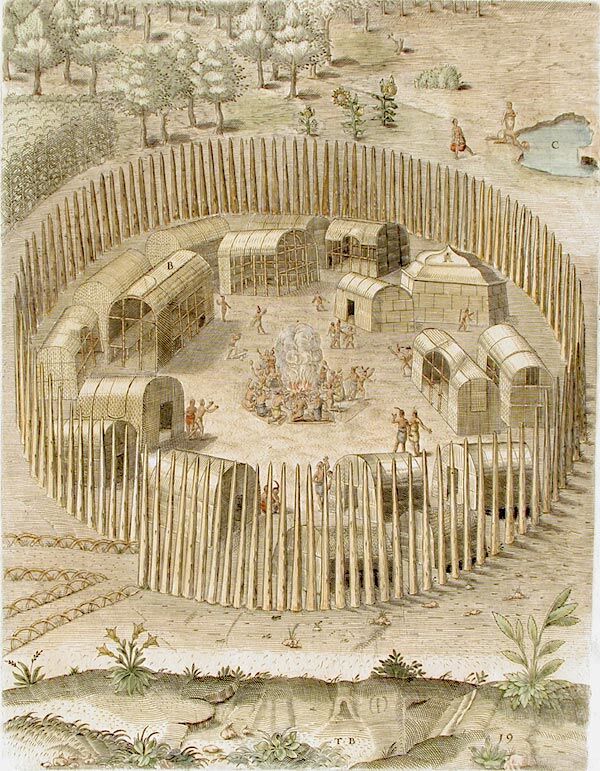
An Iroquois village
The houses are built from wood and bark. The interior is divided to provide space for each family. A single house can accommodate 24 households and 10 to 12 fires for heating and cooking. Each home has earthen benches that serve as beds.
When the Iroquois travelled, they used their canoes. However, these were much less efficient than those of the Algonquins: they were heavier and took on water easily. This is why the Iroquois bartered with neighbouring tribes to exchange food for canoes. As well as canoes, the Iroquois also used leather harnesses, toboggans and snowshoes. To speed up travel, they also used baby carriers.
Iroquois clothing is fairly simple and made from animal skins. In summer, both men and women go bare-chested and wear sandals made of woven corn. The men wear a loincloth and the women wear a tunic or skirt. In winter, they all add capes, tuques, moccasins and fur gloves to their clothing.
Among the Iroquois, men and women had different roles. The men did the heavy work: cultivating the fields, clearing the land, building the houses, etc. They also looked after external relations, hunting and fishing. They were also responsible for external relations, hunting and fishing. For hunting, the men use weapons such as blowpipes, darts and stunners. The women look after the house, the crops, the pottery and the crafts. They make necklaces, bracelets and other jewellery. It is the women who manage the harvests and have economic power. The identity of the clan is also passed on by the women.
Spiritual life is based on visions and dreams. The Iroquois shamans form the False Faces society of healers, who produce wooden masks and perform rites to heal the sick. The Iroquois chief does not issue orders. Whether in domestic or external matters, all the Iroquois have individual autonomy. The chief makes proposals to the members of the tribe. The main activities include dancing, singing, sport (lacrosse) and gambling.
These horse-drawn buffalo hunters mainly inhabited the eastern United States today. These nomadic people lived on the plains and used tipis as their dwellings.
The Sioux people are in fact made up of 3 major groups. This group is officially known as the 7 Fire People. The name Sioux was given to them by other communities. Sioux means cheating snake. The three groups of the people of the 7 fires are the Lakota, the Dakota and the Nakota. Each of these groups is allied and named according to where they live. Sioux territory is mainly located in the northern plains of the United States.
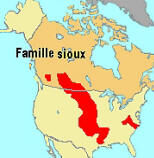
Sioux territory
Note : English image coming soon!
The Sioux's homeland is located in the east of the American continent. However, the people were hunted by other, more powerful tribes and were forced to move further and further west. During their journey, the Sioux acquired firearms and horses. These new acquisitions helped them to take possession of new lands and adapt to a new way of life. In 1805, the Sioux territory included the regions between Wyoming and Wisconsin, right up to the Canadian border. The 7 allied tribes each had their own chief.
The lifestyle of the Sioux changed as the people moved from place to place. The acquisition of horses meant that the Sioux became nomadic horse-riding tribes. As they settled on the prairies, the Sioux turned to hunting buffalo. They did not practise much agriculture, as the soils did not really support it.
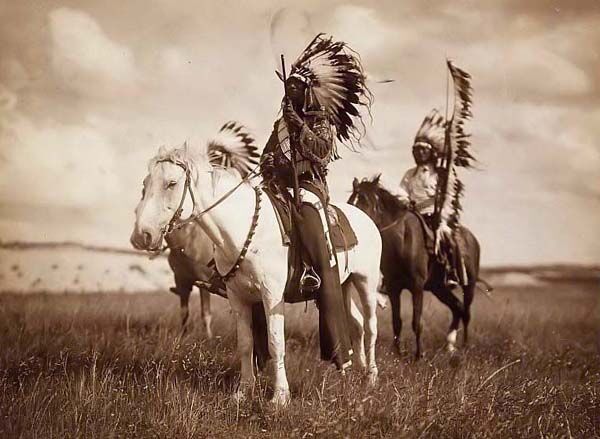
Three Sioux chiefs and their horses
The Sioux diet was based on two daily meals of bison, fruit, nuts, plants and roots. They preserved the buffalo meat by drying it. As they found it very difficult to settle in a new territory, the Sioux also adopted a much more warlike lifestyle. Their weapons developed over time and consisted mainly of knives, bows, arrows, spears and shields.
Before travelling west, the Sioux lived in earth-covered huts and tipis during the hunting season. After their migration, the Sioux adopted buffalo skin tipis for shelter. Tipis were easy to build and move around, which suited their nomadic lifestyle.
The Sioux hunted bison extensively and used every part of them. The species only became extinct when the Americans began hunting bison for commercial purposes.
The men were busy hunting buffalo, making weapons (bows and arrows) and waging war. The men protected their territory and set out to conquer new regions. Protecting the horses was also one of the most important roles: horses were the Sioux's most precious possession.
For their part, the women looked after the fire, fetched water, prepared meals and made and repaired clothes, moccasins, saddles and tools. The most skilful women made objects related to religion. As these objects were important, the women who made them were highly esteemed within the group.
Religion played an important role in the daily lives of the Sioux. For them, there was no difference between the natural and the supernatural, since life on earth was just as important as spiritual life and there was an essential link between man and the earth. This spiritual life is expressed in three important ceremonies: the sacramental pipe ceremony, the sweat lodge and the vision quest. The sacred pipe ceremony aims to communicate with the Great Spirit. To do this, the Sioux smoke tobacco and red willow bark from a sacred pipe used only in this ceremony.
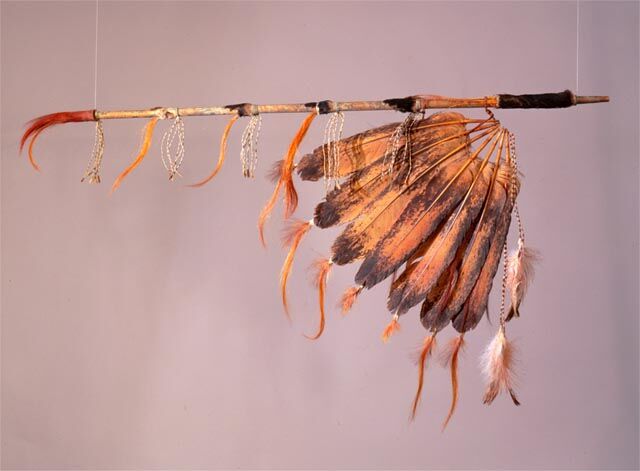
Pipe used during the ceremony
The sweat lodge is a ceremony in which people spend a certain amount of time in a teepee filled with steam. The purpose of this rite was to purify people, to help them experience a rebirth, a new lucidity. The vision quest is an initiation rite. This ceremony is in fact a test of moral and spiritual strength. The participant underwent a complete fast and was on the lookout for the visions that would come to him. After the ceremony, the Medicine Man (the intermediary between the Great Creator and the tribe) would interpret the visions. The Medicine Man is also the shaman whose main role is to heal and interpret dreams and visions.
The arrival of the white men brought a rapid end to the Sioux way of life. In addition, intensive buffalo hunting led to the extinction of the animal. Following the extinction of the species, the Sioux practised the ghost dance, which aimed to bring back the buffalo and make the whites disappear. The aim of the dance is to return to the way of life of the past. Today, however, most Sioux have adapted to city life, and many are involved in the tourism industry. The Sioux live mainly in Dakota.
